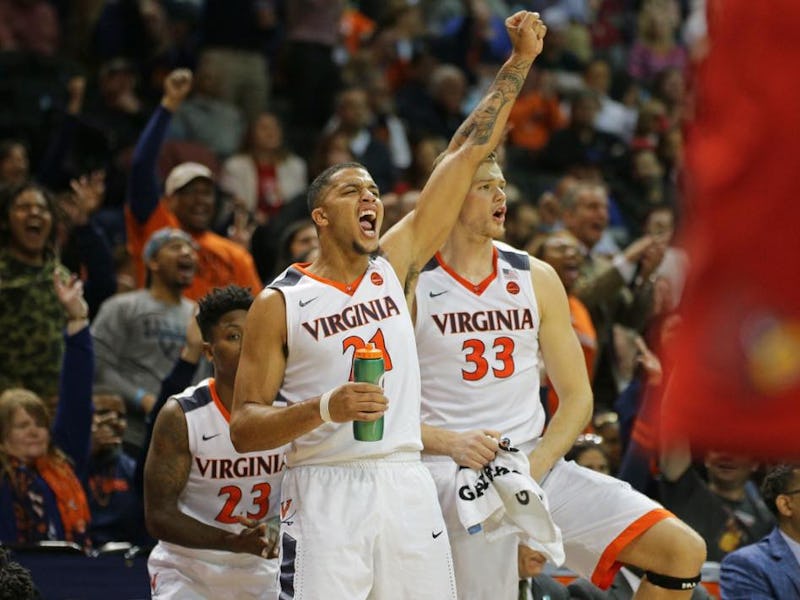The Perfect NCAA Bracket Is A.I.'s Biggest Sports Challenge Yet
When a swarm of humans, moderated by A.I. algorithms, make a choice, it's usually spot-on.

The odds of predicting a perfect NCAA tournament bracket is anywhere from 1.28 billion to 9.2 quintillion, depending on who you ask. It’s like trying to scale Mount Everest if it were 29,000 miles tall at the bottom of a deep-sea trench and in the Andromeda galaxy.
It’s just the kind of challenge the team at San Francisco-based technology firm Unanimous A.I. wants to tackle. The company’s tech brings people together online to harness and amplify their collective intelligence, forming a hive mind that can predict results with sometimes scary accuracy.
“After successfully predicting the Kentucky Derby superfecta, the exact final score of the Super Bowl, and beating all the experts with 94 percent accuracy at the Oscars last weekend, the biggest challenge left for swarm A.I. technology is the perfect March Madness bracket,” Louis Rosenberg, CEO of Unanimous A.I., tells Inverse. “Of course, the perfect bracket is an impossible goal, but the quest will keep pushing us to make our technology smarter.”
To better understand how Unanimous A.I. uses the swarm to make predictions, let’s look at its predictions for the teams most likely to make this year’s Final Four. To arrive at a finished list of picks, the swarm works through different combinations of teams, deciding which of those is least likely to make it.
Here’s an example of the swarm choosing which team is least likely to make the Final Four:
As you can see in the animation above, each participant controlled a little golden magnet and used it to drag the puck toward the answer they thought was the most likely outcome. As the users saw the puck move toward a particular outcome, it triggered a psychological response. They readjusted their decision-making, building toward a consensus, which ultimately took the form of this overall prediction. It then gets a “confidence” rating that helps rank predictions, which is why UNC ended up as the fourth most likely team to make the Final Four.
For more from Inverse on how Unanimous A.I.’s technology works, check out “Unanimous A.I. Uses Human Swarms to Make Scary-Accurate Predictions.”
How the Swarm Fared in 2017
The results for the 2017 NCAA tournament were indicative of the tech’s potential. Unanimous A.I. uses longtime ESPN college basketball analyst Joe Lunardi as its benchmark, which makes sense. Lunardi actually coined the term “bracketology” in the first place. In one experiment, a swarm of typical college basketball fans worked together to predict which of the 16 teams Lunardi identified as on the bubble would end up in the tournament.
The hive mind went a perfect 16-for-16 in predicting those teams’ fates last year. Lunardi missed on four of his 16 picks, while FiveThirtyEight only got seven of its nine picks right.
Why a Hive Mind Is Better Than One Mind
There are 351 basketball teams in NCAA Division I, which is an absurd number of teams for any one fan to follow. Even just 16 bubbles is a lot: How many fans last year were experts in the resumes of Rhode Island and the University of Southern California, or of Xavier and Illinois State, or of Georgia and* Marquette?
But that, says Rosenberg, is where the swarm intelligence approach is at its most powerful.
“College basketball is very difficult to predict because very few fans follow more than a handful of teams,” he says. “Swarm intelligence, by its very nature, assumes that every participant only has partial information about the global problem. The magic of swarming is that it enables the group to fill in the gaps in each other’s knowledge, converting on the optimal combination of their wisdom, insights, and intuitions.”
Watch Unanimous A.I. CEO Louis Rosenberg discuss the company’s technology at a TEDx talk last September:
It’s not that Unanimous A.I. had somehow assembled a group of expert bracketologists. When filling out their own individual brackets, the swarm participants averaged results in the 51st percentile.
A group of college basketball fans became borderline clairvoyant when working together: “We’re always amazed at how smart groups can be when we combine their knowledge as a swarm, enabling them to converge on optimized insights,” says Rosenberg. “March Madness last year was one of the more remarkable examples of that, as we took a population of average performers — right around the 50th percentile in performance — and when they worked together as a swarm A.I. system, moderated by A.I. algorithms, they performed in the 99th percentile. That’s just crazy.”
Eventually, the dream of a perfect bracket fell by the wayside, thanks mostly to top-seeded Villanova falling in the second round to underdog Wisconsin. It still finished between the 85th and 90th percentile, an excellent record by all but the most impossibly demanding of measures.
But then, it’s that standard that keeps Rosenberg and Unanimous A.I. going as they gear up for another run at perfection — if not 63-0, then at least still closer to a spotless 32-0 for the opening games.
Unanimous A.I. will use a swarm of fans to predict the first round on the Tuesday and Wednesday before games tip off. Rosenberg welcomes any and all college basketball fans to join the hive mind. The greater the number, the smarter the swarm.